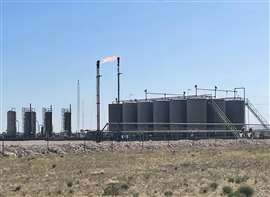Read this article in Français Deutsch Italiano Português Español
U.S. government offering $1.55 billion for methane reduction funding
25 July 2023
Funding focused on oil and gas sector
 The U.S. government plans to spend $1.55 billion for projects to help the oil and gas sector cut methane emissions. (Image: Reuters)
The U.S. government plans to spend $1.55 billion for projects to help the oil and gas sector cut methane emissions. (Image: Reuters)
U.S. government agencies are offering up to $1.55 billion in funding for projects to monitor and reduce methane emissions in the oil and gas sector.
The U.S. Environmental Protection Agency (EPA), U.S. Department of Energy (DOE), and DOE’s National Energy Technology Laboratory (NETL) released a notice of intent announcing the first in a series of funding opportunities for those projects as well as for environmental restoration of well sites. The EPA and DOE will also partner to offer technical assistance to help companies monitor and reduce methane emissions from leaks and daily operations. These funding opportunities are made possible by the Inflation Reduction Act.
“The amount of methane emitted from oil and gas operations is enough to fuel millions of homes a year and is a major driver of the climate crisis,” said Joe Goffman, Principal Deputy Assistant Administrator for EPA’s Office of Air and Radiation. “These programs will help minimize that waste, a benefit for nearby communities and businesses alike.”
Methane’s potency as a greenhouse gas makes targeted emissions reduction efforts essential to slow the rapid rate of climate change, said Brad Crabtree, Assistant Secretary of Fossil Energy and Carbon Management.
“These programs will help states and industry to accelerate methane monitoring and mitigation efforts, which will increase efficiency and reduce costs for oil and gas producers, while providing long lasting climate and health benefits to communities across the nation,” Crabtree said.
As described in the notice of intent, EPA and DOE will provide up to $350 million in formula funding to eligible states to assist industry to voluntarily identify and permanently reduce methane emissions from low-producing (marginal) conventional wells. These investments are expected to improve the economic competitiveness of small and medium-sized producers while reducing associated harmful air pollution, mitigating health effects in nearby communities, and creating jobs in energy communities. States also will be able to use a portion of their award for environmental restoration and to invest in their monitoring capacity for low-producing conventional wells, which will improve their ability to identify sources of methane emissions and to effectively prioritize their mitigation. NETL plans to issue the funding opportunity announcement later this summer.
Following this non-competitive solicitation, EPA and DOE intend to offer one or more additional competitive solicitations to monitor and mitigate methane emissions from the oil and gas sector, which will be available to a broader range of applicants. These subsequent funding opportunities are expected to advance the deployment of technologies and practices to monitor and reduce emissions of methane and other greenhouse gases. A separate financial assistance program for Tribal governments is also expected to be offered.
In addition to funding opportunities, through this collaboration, EPA and DOE will provide technical assistance to help states, industry, and other partners implement cost-effective solutions that reduce methane leak emissions. The agencies will support small and medium-sized producers that often lack the capital and expertise of the larger oil and gas companies and will work with partners to implement and prioritize best practices and mitigation decision-support tools across the broader oil and gas sector. This technical assistance will also ensure efforts are fully aligned with the needs of local communities and help inform key decision-makers of mitigation opportunities across states, industry, and other partners.
The Methane Emissions Reduction Program allows financial and technical assistance for a number of activities, including: preparing and submitting greenhouse gas reports, monitoring methane emissions, and reducing methane and other greenhouse gas emissions by improving and deploying equipment, supporting innovation, permanently reducing wasteful methane emissions from low-producing conventional wells, mitigating health effects in low-income and disadvantaged communities, improving climate resiliency, supporting environmental restoration, and mitigating legacy air pollution.
POWER SOURCING GUIDE
The trusted reference and buyer’s guide for 83 years
The original “desktop search engine,” guiding nearly 10,000 users in more than 90 countries it is the primary reference for specifications and details on all the components that go into engine systems.
Visit Now
STAY CONNECTED




Receive the information you need when you need it through our world-leading magazines, newsletters and daily briefings.
CONNECT WITH THE TEAM













